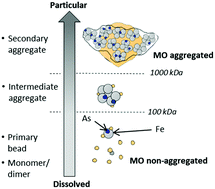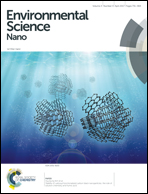Characterization of iron–organic matter nano-aggregate networks through a combination of SAXS/SANS and XAS analyses: impact on As binding
Abstract
Nanoparticles play an important role in controlling the mobility of pollutants such as arsenic (As) in the environment. In natural waters, aggregates of nanoparticles can be constituted of organic matter (OM) associated with iron (Fe). However, little is known about their network structure, especially the role of each component in the resulting aggregate morphology. This network structure can be of major importance for the metal and metalloid sorption processes. We synthesized an aggregate model of nanoparticles by varying the Fe/organic carbon (OC) ratio (R). By coupling small-angle neutron and X-ray scattering (SANS, SAXS), dynamic light scattering (DLS), transmission electron microscopy (TEM) and X-ray absorption spectroscopy (XAS), we revealed the fractal organization of Fe (i.e. primary beads forming a nanoparticle called an intermediate aggregate and then forming a secondary aggregate of nanoparticles). As the aggregate size increases with R, the As adsorption rate increases at a constant As/Fe ratio. Two hypotheses were considered: with increasing R, i) the repulsion interactions between the nanoparticles increase, inducing a structure opening, and ii) the Fe part size increases more strongly and is more ramified than the OM part, leading to a decrease of the coating by OM. Both hypotheses involve an increase in the number of available As binding sites. This study offers new perspectives on the impact of the network structure of heterogeneous nano-aggregates on their sorption capacity and could explain some metal/metalloid sorption variations observed in natural samples with variations in Fe/OC ratios.



 Please wait while we load your content...
Please wait while we load your content...